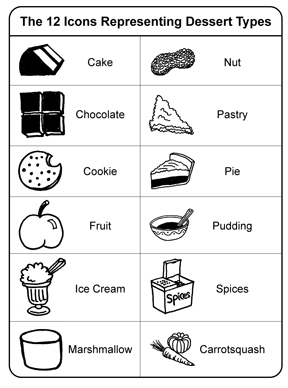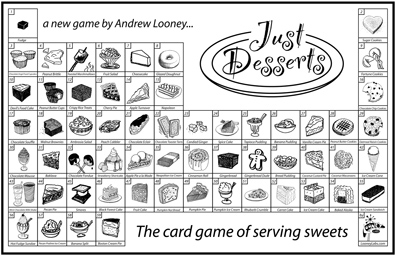|
||
|
SETUP: Shuffle the Dessert deck and deal 5 cards to each player. Shuffle the Guest deck, deal out 5 cards, and place them face up in the center of the table. PLAYING: On your turn, you play as many of your Dessert cards as is necessary, to satisfy as many Guests as possible (though you may elect not to satisfy some guests for strategic reasons). Sometimes a Guest can be satisfied with just one Dessert card, but in other cases, it may take as many as 3 cards to fulfill a Guest's desires. A Guest who dislikes something cannot be given any cards that bear the undesired icon. Your turn ends immediately if you satisfy a guest with their favorite Dessert. When you're done, you draw back up to 5 cards (from either the draw pile or the discard pile) and play passes to the next person. CLAIMING A GUEST: Whenever you play the necessary combination of Desserts required to satisfy a particular Guest, the Dessert cards you play are collected into your own local Foods Eaten pile, face up. The Guest card is placed separately in front of you, face up and pointing away from you, so that others in the game can most easily see what flavors your Guests find favorable. NEW ARRIVALS: In between each player's turn, new Guest cards are turned up as needed to replace those in the center that were claimed by the previous player, so that there are always 5 Guests in the middle at the start of a player's turn. STEALING A GUEST: At first, all available Guests will be in the center of the table, but after they get Dessert, they'll hang around in front of the last player who fed them until someone else lures them away. You are welcome to offer your Desserts to any Guest (other than those that are in front of you) but if you claim a Guest that someone else has already satisfied, you must also compensate the waiter whose customer you are stealing. This is done by giving the player you steal from an extra Dessert card, of your choice, from your hand into theirs. (If you don't have an extra Dessert available to offer as a bribe, you cannot steal a Guest.) PLAYING FAVORITES: Everyone at the party (except Nature
Girl) has a Favorite Dessert. (Two of the Guests have two Favorites.)
The Guest cards indicate which Dessert(s) are their Favorites,
but you should also be aware that all cards with 3 symbols are
the Favorite of someone. When you give a Guest his Favorite,
you get double points for that Guest. Having been satisfied completely
by their Favorite, that guest wants nothing else and leaves the
party. The Dessert card goes into your Foods Eaten pile as usual,
but the Guest card is turned face down and kept in a separate
pile in front of you. This Guest can no longer be stolen from
you. Your turn ends as soon as you give a Favorite to a Guest.
(The time it takes for you to listen to the Guest's happy compliments
- and more importantly, to receive your extra gratuity - leaves
you unable to serve anyone further on this turn.) RETURNING TO THE KITCHEN: If you lack the right combination of Dessert cards needed to satisfy any of the available guests, then you get to "go back to the Kitchen" and draw an extra card. While back there, you may choose to discard some or all of the cards in your hand, and draw to replace them. Dessert cards discarded in this way are left face up next to the draw pile. When drawing at the end of a turn, subsequent players may choose between taking a fresh card from the Draw pile, or taking a previously discarded Dessert from the top of the Discard pile. (To restate the rule, just for clarity: If you can't play, you may discard what you don't want, and draw back to one card more than what you had.) THE KITCHEN IS CLOSED: Once all the available Dessert cards have been drawn, the Kitchen is said to be closed, which means you don't get to draw any more new cards. You may pass on your turn if you can neither satisfy a Guest nor draw any new Dessert cards. However, the game continues until all players declare themselves unable to satisfy any more Guests. SCORING: You get 1 point for each Dessert card in your Foods Eaten pile. You get 1 point for each Guest you have face up in front of you, and you get 2 points for each Guest face down in your Favorites pile. Add up the points: high score wins! BREAKING TIES: In the event of a tie, the player with the most uneaten food cards leftover in his or her hand is the winner. (The idea here is that leftovers are good because each waiter gets to take home a doggie bag containing any uneaten Desserts they have left.) WHO GOES FIRST: The game begins as soon as someone declares that they have the Desserts required to claim a particular Guest. That player then goes first. |
||
|
THE PERSONAL FAVORITES VARIATION: For this you will need some small slips of paper and writing implements. Before the cards are dealt, all players write down their name and the name of whichever Dessert card most closely resembles their own personal favorite Dessert. These slips of paper are hidden until the end of the game. During scoring, any player who has their own personal favorite Dessert card leftover in their hand gets an extra 3 points! THE TURNLESS VARIATION: Once everyone has mastered the standard game, you may wish to try playing it the high-speed way, in which everyone plays at once instead of taking turns. One person (known as the Maitre d') will refrain from competing, and instead will focus on making sure the game is running smoothly, dealing out new Guests as they are needed, and checking the icons on the cards being played to make sure the Guests' desires are being properly fulfilled. Players call out the name of the Guest they are claiming as they lay down the required Dessert cards from their hand. Play proceeds as fast as practical, with the Maitre d' calling a pause if she needs to verify a play. Credits: Game Design: Andrew Looney |
 CONCEPT: It's
a Dessert party featuring sweets by different caterers. The players
are waiters, each representing a company. Everyone gets a handful
of tasty Dessert cards, to be offered to the finicky Guests in
attendance at the party. Each Dessert card is marked with one
or more icons for various dessert types, while the Guest cards
indicate which types of Dessert that person finds appealing.
Naturally, people have different tastes, and some party-goers
will turn up their noses at Desserts which include ingredients
they dislike. Also, most everyone has a favorite Dessert, and
you get a bigger tip when you give the customer exactly what
they like best. When no more guests can be satisfied, the party
ends, and whoever has served the most Desserts to the most Guests
wins!
CONCEPT: It's
a Dessert party featuring sweets by different caterers. The players
are waiters, each representing a company. Everyone gets a handful
of tasty Dessert cards, to be offered to the finicky Guests in
attendance at the party. Each Dessert card is marked with one
or more icons for various dessert types, while the Guest cards
indicate which types of Dessert that person finds appealing.
Naturally, people have different tastes, and some party-goers
will turn up their noses at Desserts which include ingredients
they dislike. Also, most everyone has a favorite Dessert, and
you get a bigger tip when you give the customer exactly what
they like best. When no more guests can be satisfied, the party
ends, and whoever has served the most Desserts to the most Guests
wins!




